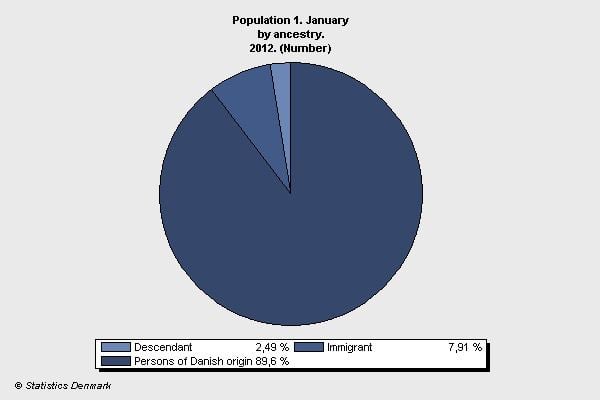This article is about the demographic features of the population of Denmark, including population density, ethnicity, education level, health of the populace, economic status, religious affiliations and other aspects of the population.
According to 1988 figures from Statistics Denmark, 89.77% of Denmark’s population of over 5,580,516 was of Danish descent, defined as having at least one parent who was born in Denmark and has Danish citizenship. Many of the remaining 10.4% were immigrants—or descendants of recent immigrants (defined as people born in Denmark from migrant parents, or parents without Danish citizenship) —less than a third of whom are from the neighbouring Scandinavian countries and Germany. Over two-thirds include people from Turkey, Iraq, Somalia, Bosnia and Herzegovina, South Asia, and from Western Asia. More than 590 000 individuals (10.4%) are migrants and their descendants (142 000 second generation migrants born in Denmark).
Of these 590 000 immigrants and their descendants:
200 000 (34%) have a Western background (Norway, Germany, Bosnia and Herzegovina, UK, Poland and Iceland; definition: EU countries, non-EU Nordic countries, Andorra, Liechtenstein, Monaco, San Marino, Switzerland, Vatican State, Canada, USA, Australia and New Zealand.).390 000 (66%) have a non-Western background (Turkey, Iraq, Jews, Romani, Somalia, Pakistan, Iran and Thailand; all other countries).According to Mete Feridun, immigration has implications for the labour market in Denmark. Moreover, according to the figures from Danmarks Statistik, crime rate among refugees and their descendants is 73% higher than for the male population average, even when taking into account their socioeconomic background. A report from Teori- og Metodecentret from 2006 found that seven out of ten young people placed on the secured youth institutions in Denmark are immigrants (with 40 percent of them being refugees).
Non-Scandinavian ethnic minorities include:
Inuit (Greenlandic) from the territory of GreenlandTurksArabs (i.e. Palestinians, followed by Moroccans, Syrians, Lebanese, Yemenis, Egyptians, Iraqis and Jordanians)VietnameseThaiJewsChinesePakistanisIraniansSomalisEthiopiansSudaneseKurdsIndiansChileans (the most numerous of Latin American nationalities)BosniaksAlbaniansBangladeshisEthnic minorities in Denmark include a handful of groups:
Approximately 15,000 people in Denmark belong to a German minority traditionally referred to as hjemmetyskere meaning "domestic Germans" in Danish, and as Nordschleswiger in German. This minority of Germans hold Danish citizenship and self-identify as Germans. Many of them use German as their home language. There are also several thousand German citizens and other ethnic Germans residing in Denmark with no historical connection to this group.An estimated 23,000 people in Denmark proper are ethnic Faroese, while 19,000 Greenlandic people reside permanently in Denmark. Many of these use the Faroese and Greenlandic languages, respectively, as their first language. All residents of the Danish Realm (viz. Denmark proper, the Faroe Islands and Greenland) normally hold Danish citizenship, unless they inherit or otherwise receive a foreign citizenship.The religiously affiliated Danish Jews number around 7,000. Secular Jews and unaffiliated ethnic Jews in Denmark number several thousand.There are approximately 15,000-20,000 Gypsies with historical ties to Denmark, excluding recent immigrants and their immediate descendants.Data according to Statistics Denmark, which collects the official statistics for Denmark.
Number of births from January–September 2015 = 43,545Number of births from January–September 2016 = 46,691Number of deaths from January–September 2015 = 39,356Number of deaths from January–September 2016 = 39,260Natural growth from January–September 2015 = 4,189Natural growth from January–September 2016 = 7,431The Church of Denmark (Den danske folkekirke) is state-supported and, according to statistics from January 2006, accounts for about 80% of Denmark's religious affiliation. Denmark has had religious freedom guaranteed since 1849 by the Constitution, and numerous other religions are officially recognised, including several Christian denominations, Muslim, Jewish, Buddhist, Hindu and other congregations as well as Forn Siðr, a revival of Scandinavian pagan tradition. The Department of Ecclesiastical Affairs recognises roughly a hundred religious congregations for tax and legal purposes such as conducting wedding ceremonies.
Islam is the second largest religion in Denmark.
For historical reasons, there is a formal distinction between 'approved' (godkendte) and 'recognised' (anerkendte) congregations of faith. The latter include 11 traditional denominations, such as Roman Catholics, the Reformed Church, the Mosaic Congregation, Methodists and Baptists, some of whose privileges in the country date hundreds of years back. These have the additional rights of having priests appointed by royal resolution and to christen/name children with legal effect.
Denmark's population from 1769 to 2007.
Source Statistics Denmark, "Folketal efter hovedlandsdele (summariske tal fra folketællinger)" (table FT) [1]To curb population decline, Denmark began subidizing the Do it for Denmark advertising campaign in 2014.The following demographic statistics are from the CIA World Factbook, unless otherwise indicated.
Population:
5,500,510 (July 2009 est.)country comparison to the world: 109Age structure:
0–14 years: 18.1% (male 511,882/female 485,782)15–64 years: 65.8% (male 1,817,800/female 1,798,964)65 years and over: 16.1% (male 387,142/female 498,940) (2009 est.)Median age:
total: 40.5 yearsmale: 39.6 yearsfemale: 41.3 years (2009 est.)Population growth rate:
0.28% (2009 est.)country comparison to the world: 175Net migration rate:
2.20 migrant(s)/1,000 population (2015 est.)country comparison to the world: 49Urbanisation:
urban population: 87% of total population (2008)rate of urbanisation: 0.5% annual rate of change (2005-10 est.)Sex ratio:
at birth: 1.06 male(s)/femaleunder 15 years: 1.05 male(s)/female15–64 years: 1.01 male(s)/female65 years and over: 0.78 male(s)/femaletotal population: 0.98 male(s)/female (2009 est.)Infant mortality rate:
total: 4.34 deaths/1,000 live birthscountry comparison to the world: 203male: 4.39 deaths/1,000 live birthsfemale: 4.29 deaths/1,000 live births (2009 est.)Life expectancy at birth:
total population: 78.3 yearscountry comparison to the world: 45male: 75.96 yearsfemale: 80.78 years (2009 est.)Total fertility rate:
1.88 children born/woman (2010 est.)country comparison to the world: 166HIV/AIDS - adult prevalence rate:
0.2% (2007 est.)country comparison to the world: 104HIV/AIDS - people living with HIV/AIDS:
4,800 (2007 est.)country comparison to the world: 124HIV/AIDS - deaths:
fewer than 100 (2003 est.)country comparison to the world: 129Nationality:
noun: Dane(s)adjective: DanishEthnic groups:
BosniaksScandinavianInuitFaroeseGermanTurkishIranianSomaliReligions:
Evangelical Lutheran 95%Other Christian (includes Protestant and Roman Catholic) 3%Muslim 2%Languages:
DanishFaroeseGreenlandic (an Inuit dialect)German (small minority)Literacy:
definition: age 15 and over can read and writetotal population: 99%male: 99%female: 99% (2003 est.)School life expectancy (primary to tertiary education):
total: 17 yearsmale: 16 yearsfemale: 17 years (2006)Education expenditures:
8.3% of GDP (2005)country comparison to the world: 12
